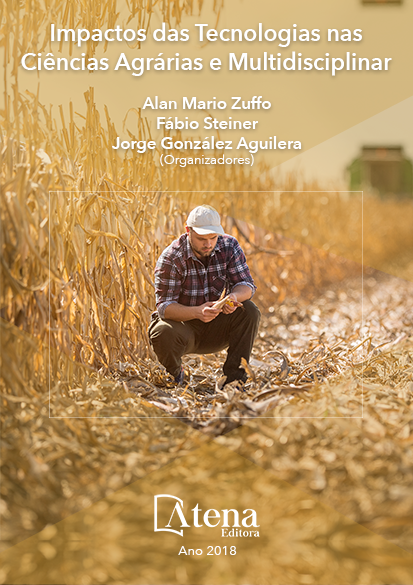
CARACTERÍSTICAS MORFOLÓGICAS DE PLANTAS E COMPONENTES DE RENDIMENTO DE MILHO EM FUNÇÃO DA DENSIDADE DE PLANTAS
O avanço do melhoramento
genético na cultura do milho, tornou-se possível
aumentar a densidade de plantas, havendo a
necessário avaliar práticas de manejo para
cultura. O estudo tem objetivo de avaliar as
características morfológicas de plantas e os
componentes de rendimento, do híbrido de milho
2B587Hx, cultivado em safrinha, com distintas
densidades de plantas. O trabalho foi realizado
no município de Dois Vizinhos, Sudoeste do
Paraná, sendo a semeadura realizada em
15/01/2015, utilizando quatro densidades de
semeadura 45, 55, 65 e 75 mil plantas ha-1 e
espaçamento de 45 cm entre linhas. Quanto
as características morfológicas de plantas,
foi avaliado o diâmetro do colmo, altura de
inserção da primeira espiga e altura final de
plantas. Para os componentes de rendimento
avaliou-se estande final de plantas (EFP),
número de fileira por espiga (NFE), número de
grãos por fileira (NGF), número de grãos por espiga (NGE), umidade do grão (UMID),
massa de mil grãos (MMG) e produtividade. A altura da primeira espiga, com valores
de 118 e 111 cm para as densidades de 75 e 45 mil plantas respectivamente, diferiu
estatisticamente. Observou-se que a densidade de 45.000 plantas ha-1 proporcionou
maiores valores de NGF e NGE na comparação com a densidade de 75.000 plantas
ha-1. Já as densidades de 45 e 55 mil plantas ha-1 obtiveram MMG de 373 gramas,
diferindo das densidades 65 e 75 mil plantas ha-1, nos quais observou-se valores 346
e 345 gramas, respectivamente. Observou-se produtividade média de 9.980 Kg ha-1,
não sendo constatadas diferenças.
CARACTERÍSTICAS MORFOLÓGICAS DE PLANTAS E COMPONENTES DE RENDIMENTO DE MILHO EM FUNÇÃO DA DENSIDADE DE PLANTAS
-
DOI: Atena
-
Palavras-chave: Milho Safrinha, produtividade, Zea mays
-
Keywords: Second crop, productivity, Zea mays
-
Abstract:
The advancement of genetic improvement in the corn crop, it became
possible to increase the density of plants, and it was necessary to evaluate management
practices for cultivation. The objective of this study was to evaluate the morphological
characteristics of plants and the yield components of the 2B587Hx maize hybrid,
cultivated in the second crop, with different plant densities. The work was carried out
in the municipality of Dois Vizinhos, South-west do Paraná, with sowing performed on
01/15/2015, using four sowing densities 45, 55, 65 and 75 thousand ha-1 plants and
45 cm spacing between rows. Regarding the morphological characteristics of plants,
the diameter of the stalk, height of insertion of the first spike and final height of plants
were evaluated. For the yield components, final plant stand (FPS), number of row per
spike (NRPS), number of grains per row (NGPR), number of grains per spike (NPS),
grain moisture, mass of a thousand grains (MTG) and productivity. The height of the
first spike, with values of 118 and 111 cm for the densities of 75 and 45 thousand plants
respectively, differed statistically. It was observed that the density of 45,000 ha-1 plants
provided higher values of NGPR and NPS in comparison to the density of 75,000 ha-1
plants. The densities of 45 and 55 thousand plants ha-1 obtained MTG of 373 grams,
differing from the densities 65 and 75 thousand plants ha-1, in which values 346 and
345 grams were observed, respectively. The average productivity of 9,980 Kg ha-1 was
observed, with no differences being observed.
-
Número de páginas: 15
- Vanderson


